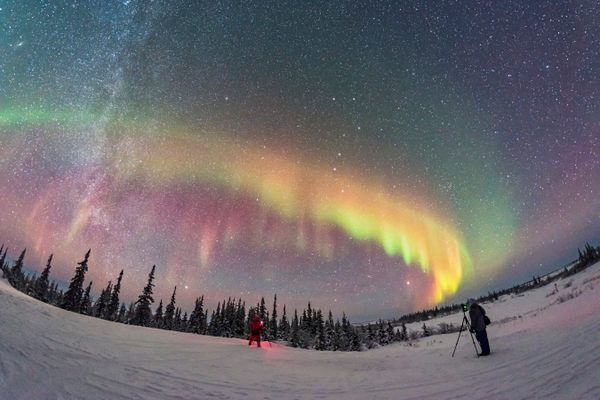How to See Venus and Mars in the Summer Sky
Our nearest planetary neighbors can help you map your place in the solar system.
Atlas Obscura’s Wondersky columnist Rebecca Boyle is an award-winning science journalist and author of the upcoming Our Moon: How Earth’s Celestial Companion Transformed the Planet, Guided Evolution, and Made Us Who We Are (January 2024, Random House). Throughout the summer, she’ll be sharing the stories and secrets of our wondrous night sky.
Some people speak of the night as the time when the stars come out. But they are always out. We are always surrounded by them and among them, even though the star closest to us, the sun, outshines them. I prefer to think of the night as the time when the sun lets its fellow stars have their turn.
Half of the precious time we have on this planet is during the night. But much of our allotment of starlight is drowned out either by the sun or by the bright light of the 24-hour civilization we have created. I am hoping that will change for some of you this summer, that you stay up a little later, or begin your mornings a little earlier. I hope that, by being out at night and feeling it blanket you, you might come to understand the fullness of the darkness in a new way.
We’re not all that alone, after all, not really. Summer nights offer an easy, obvious reminder that we are enrobed in cosmic dust and errant space rocks; surrounded by nebulae and star clusters; visited by comets; and cocooned by artificial satellites, as we sit here on one of eight worlds in our solar system, which is but one of uncountable star systems inside so many galaxies, themselves bound within so many galaxy clusters. Stargazing is a hobby of fellowship.
Stargazing usually refers to the stars, obviously, but for many people—myself included—the moon and the planets are the gateway. To meet our nearest planetary neighbors, look to the western horizon not long after sunset. There, in the blues and purple-pink skies, look for a very bright star, which is actually the planet Venus.
On June 4, the sun’s second planet reached its greatest elongation, which just means it is as far as it can get from the sun. (So close to the sun, Venus is bound to our star as if by an invisible string, and is always found near sunrise or sunset, never midnight.)
The next few evenings will be a good time to look at Venus with your naked eyes, through binoculars, or through a telescope. The latter option might well blow your mind: Through a telescope’s magnification, Venus won’t look like a round planet, but instead like a half-moon, first quarter phase.

Venus is beautiful in its own right, but it is also one of the simplest waypoints to orient yourself in the night sky. To the left of Venus, a few degrees higher on the horizon, you can find another bright star: the planet Mars. The fourth planet is dimmer, but should still be easy to find with its reddish tinge. If you found both of those, congratulations: You are a citizen of the solar system. Then look above them both, to one of the most familiar asterisms in the night sky: The Big Dipper, or part of the constellation Ursa Major. Its “scoop” will be pointing away from Mars and Venus.
These objects, including the stars of Ursa Major, are very bright and should be visible from almost anywhere in the Northern Hemisphere. When you first step outside, their light may seem feeble at first, especially in or near urban areas. But sit out in the darkness for a while, and your pupils will dilate enough to see more and more.
Notice what changes in the sky. Is there anything moving? Not the predictable staccato blinking of an airplane, but a point of light slowly arcing across the sky? This is a satellite. Is there anything moving more quickly, a green flash gone in a moment? This is a meteor, maybe a rock left over from the origin of the planets, or some interplanetary dust burning up in Earth’s atmosphere. The longer you look, the more you will see. One pleasant fact about summer nights is that they seem to go on forever. It rarely gets so cold that you can no longer stand to be outdoors, and the sounds of the life around you, human or otherwise, will keep you company.
The night is something we all share, and I think it is something we should all acclaim; stargazing is the best way I’ve found to do that, and to more fully appreciate our place in the cosmos. And one wonderful thing about stargazing is that it can be as simple or as complicated as you want. Next week I will introduce you to some basic tools of the trade, and some level-up picks for people who know their way around the sky. But no matter your skills or equipment, the most important thing is to go outside, preferably when it’s dark, and look up. You are here.
Is there something you’d like to know about our brilliant night sky? Share your stargazing questions with us and you may see them answered in a future Wondersky column!










Follow us on Twitter to get the latest on the world's hidden wonders.
Like us on Facebook to get the latest on the world's hidden wonders.
Follow us on Twitter Like us on Facebook